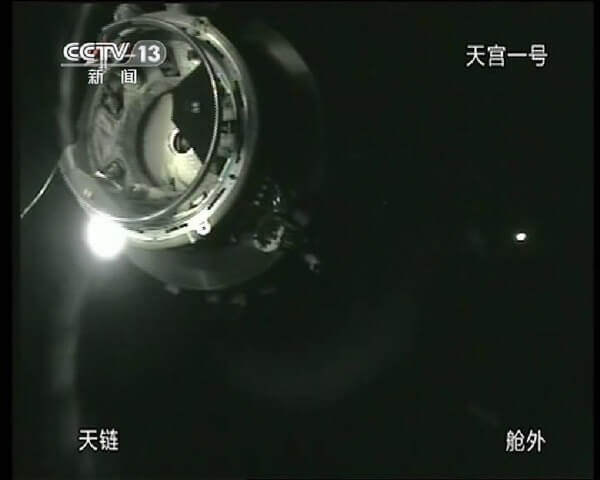This is the first time that the Chinese manage to connect two spacecraft in orbit, another step towards establishing a manned space station

Two Chinese spacecraft completed China's first space docking in the early hours of Thursday (today) China time. The connection was made at an altitude of 343 km above the earth's surface. Almost two days after launch at 01:36 local time (19:36 Wednesday Israel time), the unmanned Shenzhou 8 spacecraft docked in the Tiangong-1 space module. The success of the docking process makes China the third country in the world after the USA and Russia to specialize in the techniques, which advances China another step towards building its own space station. Chinese President Hu Jintao, who is in France for the G-20 conference, sent his blessing on the success of the operation. Breakthroughs in space docking technology are essential to the three-phase strategy of the Chinese space program, Hu wrote. Members of the Politburo Standing Committee of the Chinese Communist Party watched the mission from the control center in Beijing. China is now equipped with the basic technology needed to assemble a space station, says Zhu Jainping, chief planner of China's manned space program. This would allow China to conduct flights on a much larger scale, he said. The first space docking in history occurred in 1966 when the manned American spacecraft Gemini 8 docked with an unmanned target vehicle. 45 years later, the maneuver remains a technological challenge, the over 300 attempts made so far at docking in space have been accompanied by difficulties or failures. "There is no margin of error of more than 20 centimeters when it comes to a vessel that flies at a speed of 7.8 kilometers per hour," says Zhou. "It's like finding a needle in a haystack." The Shenzhou 8 and Tiangong-1 spacecraft will separate and fly side-by-side for 12 days, after which another docking maneuver will take place. The rendezvous and connection of spacecraft is essential to a manned space program, and this ability allows space stations to be established, supplies to be launched to them, astronauts or ticonauts in Chinese, and their rescue. Without this knowledge, the journey to the moon and beyond will require launchers with enormous propulsion capacity.
China does not currently have missiles of such power. Shenzhou 8 and Tiangong 1 weigh 8 tons each, within the capability range of Long March 2F missiles. A permanent space station is planned for a weight of 60 tons, with docking facilities serving both manned flights and cargo flights. The interior of the spacecraft is arranged so that the astronauts can live and work. After the Shenzhou 8 test is completed, Tiangong-1 will remain in space and will remain a target satellite for further dockings in 2012 by the Shenzhou 9 and 10 spacecraft, at least one of which will be manned and the docking will be manual in order to train the astronauts. Two female astronauts are currently training for the mission, said Chen Shengguang, director of the China Astronaut Center (ACC). The laboratory will also serve experiments that will be carried out as part of the agreement between China and Germany for technological cooperation in space. German engineers designed bio-incubators for the experiments, and their Chinese counterparts were responsible for developing the control equipment, China's manned space program spokesman Wu Ping told China's official Xinhua news agency. For information on the Chinese government website

7 תגובות
Does anyone know what the optimal weight is to send into space. For each unit of weight, add another weight that will take it.
There is some optimal point where they say that for every additional unit of weight, the utility of sending decreases.
?
By the way, if Obama doesn't wake up quickly, he will find the USA behind in the field of space, which there is no doubt that the one who controls it will dictate the pace of life!!!
Simon:
Maybe the whole article should be written in Chinese and not just the word astronaut?
Docking in space is nothing more, they will try to be admitted to medicine in Israel..
The achievements of the Chinese are amazing.
It is even more amazing to see how the Americans neglected their space program and abandoned the field to other countries...
The Chinese called them astronauts, maybe tycoons, this is no longer politically correct in China either?
In any case, I will add in brackets.
Shimon, that's true, but let's assume for accuracy, because we all understood the article. Three, three. And what is the difference? Ask the language experts.
tychonautics
and not astronautics. They are not from America. from china
After all, you have already labeled the domain properly.
Put parentheses in the first term and correct the rest.
https://www.hayadan.org.il/topic/טייקונאוט/